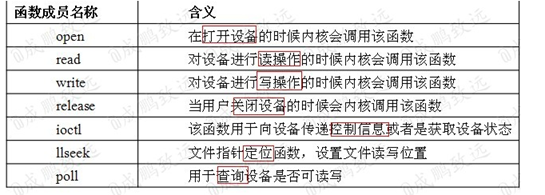一.如何写驱动呢?
先讲解驱动框架,然后写出first_drv驱动程序,来打印一些信息
写出first_drv驱动程序需要以下几步:
(1)写出驱动程序first_drv_open first_drv_write
(2)需要定义file_operations结构体来封装驱动函数first_drv_open first_drv_write
对于字符设备来说,常用file_operations以下几个成员:

(3) 模块加载函数,通过函数 register_chrdev(major, “first_drv”, &first_drv_fops) 来注册字符设备
(4)写驱动的first_drv_init 入口函数来调用这个register_chrdev()注册函数,
(5)通过module_init()来修饰入口函数,使内核知道有这个函数
(6)写驱动的first_drv_exit出口函数,调用这个unregister_chrdev()函数卸载,
(7) 通过module_exit()来修饰出口函数
(8) 模块许可证声明, 最常见的是以MODULE_LICENSE( “GPL v2” )来声明
二 编写驱动代码
- 头文件
/* 参考drivers\input\keyboard\gpio_keys.c */
#include <linux/module.h>
#include <linux/version.h>
#include <linux/init.h>
#include <linux/fs.h>
#include <linux/interrupt.h>
#include <linux/irq.h>
#include <linux/sched.h>
#include <linux/pm.h>
#include <linux/sysctl.h>
#include <linux/proc_fs.h>
#include <linux/delay.h>
#include <linux/platform_device.h>
#include <linux/input.h>
#include <linux/irq.h>
#include <asm/gpio.h>
#include <asm/io.h>
#include <asm/arch/regs-gpio.h>
- 定义input_dev结构体
struct input_dev {
void *private;
const char *name; //设备名字
const char *phys; //文件路径,比如 input/buttons
const char *uniq;
struct input_id id;
unsigned long evbit[NBITS(EV_MAX)]; //表示支持哪类事件,常用有以下几种事件(可以多选)
//EV_SYN 同步事件,当使用input_event()函数后,就要使用这个上报个同步事件
//EV_KEY 键盘事件
//EV_REL (relative)相对坐标事件,比如鼠标
//EV_ABS (absolute)绝对坐标事件,比如摇杆、触摸屏感应
unsigned long keybit[NBITS(KEY_MAX)]; //存放支持的键盘按键值
//键盘变量定义在:include/linux/input.h, 比如: KEY_L(按键L)
unsigned long relbit[NBITS(REL_MAX)]; //存放支持的相对坐标值
unsigned long absbit[NBITS(ABS_MAX)]; //存放支持的绝对坐标值
unsigned long mscbit[NBITS(MSC_MAX)]; //存放支持的其它事件,也就是功能
unsigned long ledbit[NBITS(LED_MAX)]; //存放支持的各种状态LED
unsigned long sndbit[NBITS(SND_MAX)]; //存放支持的各种声音
unsigned long ffbit[NBITS(FF_MAX)]; //存放支持的受力设备
unsigned long swbit[NBITS(SW_MAX)]; //存放支持的开关功能
... ...
- buttons_init函数实现
static struct input_dev *buttons_dev;
static int buttons_init(void)
{
int i;
/* 1. 分配一个input_dev结构体 */
buttons_dev = input_allocate_device();
/* 2. 设置 */
/* 2.1 能产生哪类事件 */
set_bit(EV_KEY, buttons_dev->evbit);//按键类事件
set_bit(EV_REP, buttons_dev->evbit);//重复类事件
/* 2.2 能产生这类操作里的哪些事件: L,S,ENTER,LEFTSHIT */
set_bit(KEY_L, buttons_dev->keybit);
set_bit(KEY_S, buttons_dev->keybit);
set_bit(KEY_ENTER, buttons_dev->keybit);
set_bit(KEY_LEFTSHIFT, buttons_dev->keybit);
/* 3. 注册 */
input_register_device(buttons_dev);
/* 4. 硬件相关的操作 */
/*4.2 定时器初始化*/
init_timer(&buttons_timer);//防抖动的
buttons_timer.function = buttons_timer_function;//定义定时器服务函数
add_timer(&buttons_timer);
/*4.2 注册4个中断*/
for (i = 0; i < 4; i++)
{
request_irq(pins_desc[i].irq, buttons_irq, IRQT_BOTHEDGE, pins_desc[i].name,&pins_desc[i]);
}
return 0;
}
分析一下:当调用input_register_device的时候dev和handler两者是否匹配?
对应的buttons_exit函数实现
static void buttons_exit(void)
{
int i;
for (i = 0; i < 4; i++)
{
free_irq(pins_desc[i].irq, &pins_desc[i]);//对应request_irq
}
del_timer(&buttons_timer);//对应add_timer
input_unregister_device(buttons_dev);//对应input_register_device
input_free_device(buttons_dev); //对应input_allocate_device
}
- 构建包含四个按键的结构体
struct pin_desc{
int irq;//中断号
char *name;//名字
unsigned int pin;//引脚号
unsigned int key_val;//键值
};
struct pin_desc pins_desc[4] = {
{
IRQ_EINT0, "S2", S3C2410_GPF0, KEY_L},//S2按键对应L..
{
IRQ_EINT2, "S3", S3C2410_GPF2, KEY_S},
{
IRQ_EINT11, "S4", S3C2410_GPG3, KEY_ENTER},
{
IRQ_EINT19, "S5", S3C2410_GPG11, KEY_LEFTSHIFT},
};
- 中断服务程序
static struct pin_desc *irq_pd;
static struct timer_list buttons_timer;//定时器相关结构体
/*按键中断服务函数*/
static irqreturn_t buttons_irq(int irq, void *dev_id)
{
/* 10ms后启动定时器 */
irq_pd = (struct pin_desc *)dev_id;
mod_timer(&buttons_timer, jiffies+HZ/100);
return IRQ_RETVAL(IRQ_HANDLED);
}
/*定时器中断服务函数*/
static void buttons_timer_function(unsigned long data)
{
struct pin_desc * pindesc = irq_pd;
unsigned int pinval;
if (!pindesc)
return;
pinval = s3c2410_gpio_getpin(pindesc->pin);
if (pinval)
{
/*
struct input_dev *dev, 设备
unsigned int type, 表示支持哪类事件,键盘事件
unsigned int code, 表示事件编码,KEY_L,KEY_S,KEY_ENTER,KEY_LEFTSHIFT
int value,松开 : 最后一个参数: 0-松开, 1-按下 自己定义即可
*/
input_event(buttons_dev, EV_KEY, pindesc->key_val, 0);
/*
*/
input_sync(buttons_dev);
}
else
{
/* 按下 */
input_event(buttons_dev, EV_KEY, pindesc->key_val, 1);
input_sync(buttons_dev);
}
}
工作流程:
初始化完成->
按键按下->
触发中断程序buttons_irq->
修改定时器,10ms后触发定时器中断->
触发定时器中断程序buttons_timer_function->
读取引脚值:按下/松开->
若按下:上报事件input_event
4.分析上报事件后面流程
- input_event函数:(上一篇分析过)
void input_event(struct input_dev *dev, unsigned int type, unsigned int code, int value)
{
struct input_handle *handle;
...
/* 通过input_dev ->h_list链表找到input_handle驱动处理结构体*/
list_for_each_entry(handle, &dev->h_list, d_node);
if (handle->open)
handle->handler->event(handle, type, code, value);
}
- 相对于之前的我们需要自己构造驱动程序的完整结构,现在输入子系统已经构造完成file_operations还有相关函数。我们只需要完成硬件这部分即可!
static const struct file_operations evdev_fops = {
.owner = THIS_MODULE,
.read = evdev_read,
.write = evdev_write,
.poll = evdev_poll,
.open = evdev_open,
.release = evdev_release,
.unlocked_ioctl = evdev_ioctl,
#ifdef CONFIG_COMPAT
.compat_ioctl = evdev_ioctl_compat,
#endif
.fasync = evdev_fasync,
.flush = evdev_flush
};
5.试验
- 修改makefile:
- 装载驱动程序:
insmod buttons.ko - ls -l /dev/event*

主设备号:13;次设备号:65;名字:event1
static int evdev_connect(struct input_handler *handler, struct input_dev *dev,
const struct input_device_id *id)
{
evdev->exist = 1;
evdev->minor = minor;
evdev->handle.dev = dev;
evdev->handle.name = evdev->name;
evdev->handle.handler = handler;
evdev->handle.private = evdev;
sprintf(evdev->name, "event%d", minor);//设备名 event1
evdev_table[minor] = evdev;
//EVDEV_MINOR_BASE=64 次设备号 64+1=65
//INPUT_MAJOR=13 主设备号13
devt = MKDEV(INPUT_MAJOR, EVDEV_MINOR_BASE + minor),
cdev = class_device_create(&input_class, &dev->cdev, devt,dev->cdev.dev, evdev->name);
}
- 测试命令-方法1:
hexdump /dev/event1;
功能:1.open(/dev/event1);2.read();3.把里面读到的数据用16进制显示出来
行号------------秒-----------微秒-------类—code—value
0000000-0bb2 0000-0e48 000c-0001-0026-0001 0000
0000010-0bb2 0000-0e54 000c-0000-0000-0000 0000
0000020-0bb2 0000-5815 000e-0001-0026-0000 0000
0000030-0bb2 0000-581f 000e-0000-0000-0000 0000
static void buttons_timer_function(unsigned long data)
{
struct pin_desc * pindesc = irq_pd;
unsigned int pinval;
if (!pindesc)
return;
pinval = s3c2410_gpio_getpin(pindesc->pin);
if (pinval)
{
/* 松开 : 最后一个参数: 0-松开, 1-按下 */
/*
type=EV_KEY=0x01;
code=pindesc->key_val=38/31/28/42=0x26/0x...;
value=0;
*/
input_event(buttons_dev, EV_KEY, pindesc->key_val, 0);
input_sync(buttons_dev);
}
else
{
/* 按下 */
input_event(buttons_dev, EV_KEY, pindesc->key_val, 1);
input_sync(buttons_dev);
}
}
- 测试命令-方法2
如果没有启动QT:
cat /dev/tty1 按:s2,s3,s4 就可以得到ls
或者:
exec 0</dev/tty1
关于exec 0</dev/tty1的解释如下:
关于标准输入输出错误:
# ls -l /proc/770/fd #770表示shell
lrwx------ 1 0 0 64 Jan 1 00:03 0 -> /dev/s3c2410_serial0 #标准输入是串口
lrwx------ 1 0 0 64 Jan 1 00:03 1 -> /dev/s3c2410_serial0 #标准输出是串口
lrwx------ 1 0 0 64 Jan 1 00:03 10 -> /dev/tty
lrwx------ 1 0 0 64 Jan 1 00:03 2 -> /dev/s3c2410_serial0 #标准错误是串口
exec 0</dev/tty1:表示将/dev/tty1的输入即键盘上的输入作为标准输入。之前是从串口上得到的输入,现在改为从键盘上得到输入。
如果已经启动了QT:
可以点开记事本然后按:s2,s3,s4
为什么启动QT后使用cat /dev/tty1 命令不能达到预期效果呢?
因为这时候执行上述指令通过tty_io.c->keyboard.c程序。keyboard.c也属于输入子系统框架,不是从buttons.c进来。
参见《韦东山第2期驱动大全-002_输入子系统_第13课第2节 keyboard.xmind》

-
测试命令-方法3
exec 0</dev/tty1-表示将/dev/tty1的输入即键盘上的输入作为标准输入
之前是从串口上得到的输入,现在改为从键盘上得到输入。 -
按下按键不松开,如何实现重复输入呢?
static int buttons_init(void)
{
...
/* 2. 设置 */
/* 2.1 能产生哪类事件 */
set_bit(EV_KEY, buttons_dev->evbit);//按键类事件
set_bit(EV_REP, buttons_dev->evbit);//重复类事件
...
}
此时,连续按下键盘时,调用input_event()
参见《韦东山第2期驱动大全-002_输入子系统_第13课第2节 键盘重复输入》